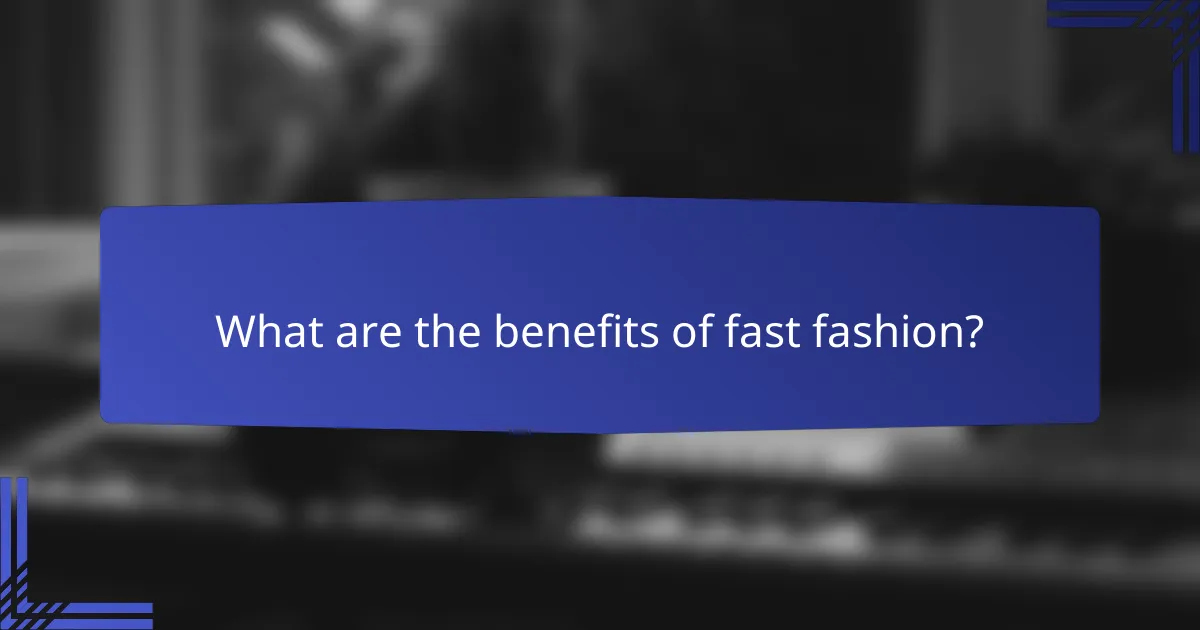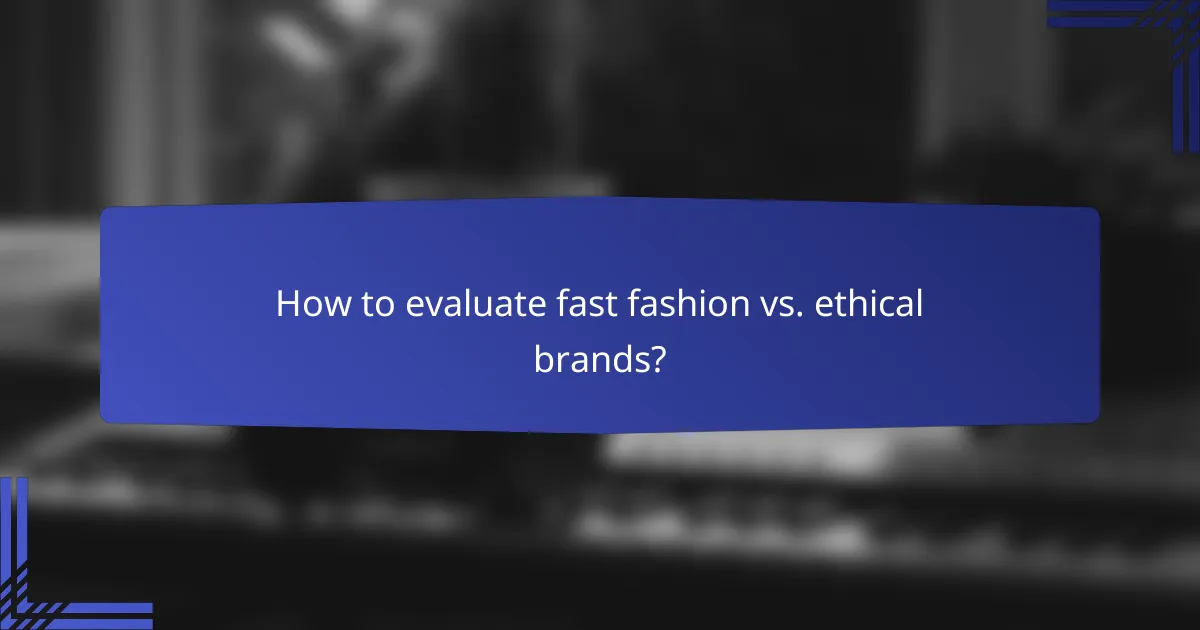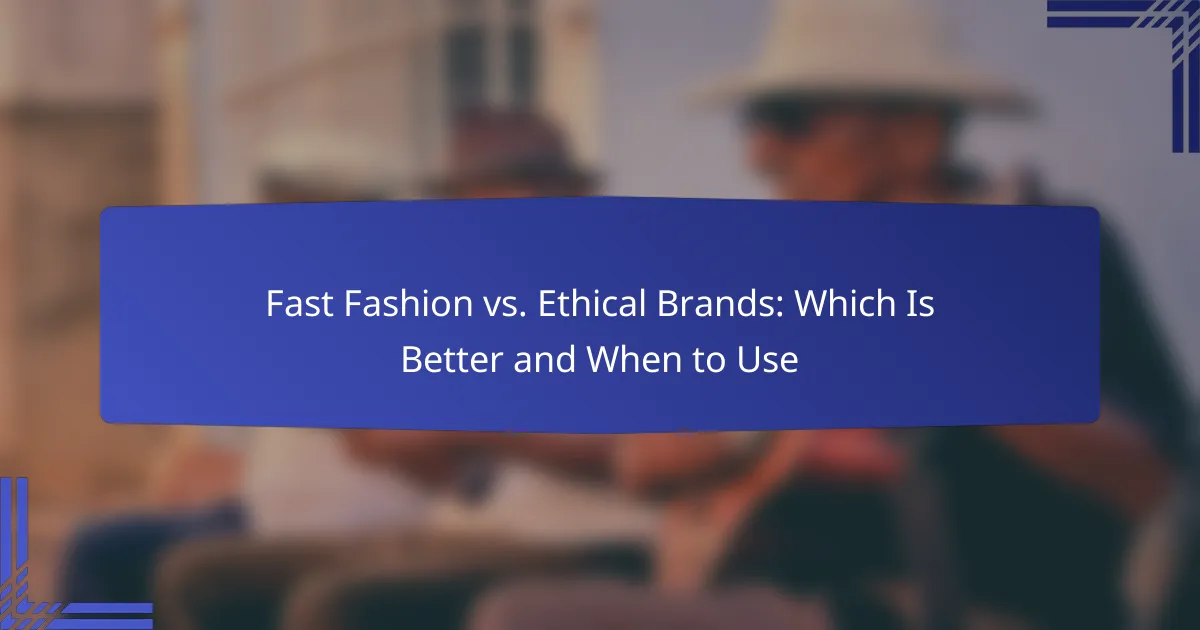In the ongoing debate between fast fashion and ethical brands, consumers face a choice that balances affordability and trendiness against sustainability and social responsibility. While fast fashion provides quick access to the latest styles at low prices, it often comes with significant environmental and ethical costs. Conversely, ethical brands emphasize quality and responsible practices, appealing to those who prioritize conscious consumerism. Understanding when to choose each option is crucial for making informed purchasing decisions.

What are the benefits of fast fashion?
Fast fashion offers several advantages, primarily centered around affordability, trend accessibility, and quick inventory turnover. These benefits make it appealing to consumers looking for stylish clothing at lower prices.
Affordability
One of the main benefits of fast fashion is its affordability. Brands often produce garments at low costs, allowing consumers to purchase trendy items without breaking the bank. Prices can range from a few dollars to low tens of dollars, making it accessible for a wide audience.
However, while the low price point is attractive, it’s essential to consider the quality and longevity of these items. Fast fashion pieces may not last long, leading to more frequent replacements and potentially higher long-term costs.
Trend accessibility
Fast fashion brands excel at making the latest trends accessible to consumers. They quickly replicate styles seen on runways or in celebrity culture, enabling shoppers to stay fashionable without significant investment. This rapid response to trends means that new styles can appear in stores within weeks of their debut.
This accessibility allows consumers to experiment with different looks and styles, catering to diverse fashion preferences. However, it can also lead to a disposable mindset regarding clothing, as trends change rapidly.
Quick inventory turnover
Fast fashion retailers are known for their quick inventory turnover, which keeps their offerings fresh and exciting. New collections can be introduced frequently, often on a weekly basis, encouraging consumers to visit stores more often to see what’s new.
This fast-paced approach can create a sense of urgency among shoppers, prompting them to buy items before they sell out. While this can be thrilling, it also contributes to overconsumption and waste, as many items are discarded after only a few wears.

What are the drawbacks of fast fashion?
Fast fashion has several significant drawbacks, including its detrimental effects on the environment, labor exploitation, and concerns regarding product quality. These issues make it essential for consumers to consider the broader implications of their purchasing decisions.
Environmental impact
The environmental impact of fast fashion is profound, contributing to pollution, waste, and resource depletion. The production process often involves toxic chemicals that can contaminate water sources and harm ecosystems.
Additionally, fast fashion promotes a culture of disposability, leading to millions of tons of textile waste each year. Many garments are discarded after just a few wears, exacerbating landfill issues and increasing carbon footprints.
Labor exploitation
Labor exploitation is a critical concern in the fast fashion industry, with many workers subjected to poor working conditions, low wages, and long hours. Factories in developing countries often prioritize profit over worker rights, leading to unsafe environments.
Brands may turn a blind eye to these practices, relying on complex supply chains that obscure the true conditions of laborers. Consumers should be aware of these issues and consider supporting brands that prioritize ethical labor practices.
Quality concerns
Fast fashion items are frequently produced with lower quality materials, resulting in garments that wear out quickly. This lack of durability means consumers may find themselves replacing items more often, ultimately leading to higher costs over time.
In contrast, investing in higher-quality, ethically produced clothing can provide better value in the long run, as these items tend to last longer and withstand wear and tear. Consumers should weigh the trade-offs between price and quality when making purchasing decisions.

How do ethical brands differ from fast fashion?
Ethical brands prioritize sustainability and social responsibility, while fast fashion focuses on rapid production and low costs. This fundamental difference affects materials, labor practices, and product longevity, making ethical options more aligned with conscious consumerism.
Sustainable materials
Ethical brands typically use sustainable materials such as organic cotton, recycled polyester, and Tencel, which have a lower environmental impact. Fast fashion, on the other hand, often relies on cheap synthetic fabrics that contribute to pollution and waste.
When choosing clothing, look for certifications like GOTS (Global Organic Textile Standard) or OEKO-TEX, which indicate environmentally friendly practices. Investing in garments made from sustainable materials can reduce your carbon footprint significantly over time.
Fair labor practices
Ethical brands commit to fair labor practices, ensuring workers receive fair wages, safe working conditions, and reasonable hours. Fast fashion brands frequently exploit cheap labor in developing countries, leading to poor working conditions and low pay.
To support ethical labor practices, seek brands that are transparent about their supply chains and adhere to standards like Fair Trade. This not only helps workers but also promotes a more equitable global economy.
Long-lasting quality
Ethical brands often emphasize long-lasting quality, producing durable clothing designed to withstand wear and tear. Fast fashion items are typically made with lower-quality materials, leading to quicker deterioration and increased waste.
When shopping, consider investing in fewer, high-quality pieces that can last for years instead of multiple trendy items that may only last a season. This approach not only saves money in the long run but also reduces environmental impact.

When should you choose fast fashion?
Fast fashion is a suitable choice when you need affordable clothing quickly and without long-term commitment. It offers trendy options at lower prices, making it ideal for specific situations.
Budget constraints
If you’re on a tight budget, fast fashion can provide a variety of stylish clothing without breaking the bank. Many fast fashion retailers offer items priced in the low tens of dollars, making it easier to refresh your wardrobe without significant financial strain.
However, be cautious of overspending. Create a budget before shopping and stick to it to avoid impulse purchases that can add up quickly.
Short-term needs
Fast fashion is perfect for short-term needs, such as attending a one-time event or seasonal occasion. If you need an outfit for a party or a vacation, fast fashion retailers can provide trendy options that suit the moment.
Keep in mind that these items may not be durable, so consider the frequency of wear. If you only plan to wear something once or twice, fast fashion can be a practical solution.
Fashion experimentation
Fast fashion allows you to experiment with different styles without a significant financial commitment. If you’re unsure about a trend or want to try a new look, purchasing inexpensive pieces can help you explore your fashion preferences.
To maximize this benefit, consider buying versatile items that can be mixed and matched. This way, you can create multiple outfits while keeping costs low.

When should you choose ethical brands?
Choosing ethical brands is ideal when you prioritize sustainability, long-lasting quality, and alignment with your personal values. These brands often focus on responsible sourcing, fair labor practices, and environmental stewardship, making them a better choice for conscious consumers.
Long-term investment
Ethical brands typically offer higher quality products that last longer than fast fashion items. Investing in durable clothing can save money over time, as you may need to purchase fewer replacements. Consider that a well-made garment from an ethical brand can often last several years, while fast fashion pieces may wear out within a season.
Support for sustainability
Choosing ethical brands supports sustainable practices that minimize environmental impact. These brands often use eco-friendly materials and production methods that reduce waste and carbon emissions. By opting for sustainable clothing, you contribute to a more responsible fashion industry and help combat issues like pollution and resource depletion.
Personal values alignment
Selecting ethical brands allows you to align your purchasing decisions with your personal values, such as social justice and environmental responsibility. If you prioritize fair labor practices and environmental conservation, supporting these brands reinforces your commitment to these principles. Look for certifications like Fair Trade or GOTS (Global Organic Textile Standard) to ensure your choices reflect your values.

How to evaluate fast fashion vs. ethical brands?
To evaluate fast fashion versus ethical brands, consider factors such as price, material sourcing, and brand transparency. Understanding these elements will help you make informed choices about your clothing purchases.
Price comparison
Fast fashion brands typically offer lower prices, often ranging from a few dollars to low tens of dollars for basic items. In contrast, ethical brands usually price their products higher, often starting in the mid-twenties to low hundreds, reflecting fair labor practices and sustainable materials.
When comparing prices, consider the cost per wear. A more expensive ethical garment may last longer and provide better value over time compared to cheaper fast fashion items that may wear out quickly.
Material sourcing
Fast fashion brands often use synthetic materials and low-cost fabrics, which can have a significant environmental impact. Ethical brands prioritize sustainable materials, such as organic cotton or recycled fabrics, which are better for the planet.
Look for certifications like GOTS (Global Organic Textile Standard) or OEKO-TEX, which indicate responsible sourcing practices. These certifications can help you identify brands committed to reducing their environmental footprint.
Brand transparency
Fast fashion brands generally provide limited information about their supply chains and labor practices. Ethical brands, on the other hand, often share detailed information about their sourcing, production processes, and labor conditions.
To assess transparency, check if a brand publishes a sustainability report or provides information on their website about their sourcing practices. Brands that are open about their operations are more likely to adhere to ethical standards.
